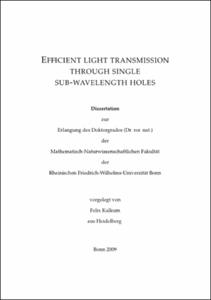Kalkum, Felix: Efficient light transmission through single sub-wavelength holes. - Bonn, 2009. - Dissertation, Rheinische Friedrich-Wilhelms-Universität Bonn.
Online-Ausgabe in bonndoc: https://nbn-resolving.org/urn:nbn:de:hbz:5N-19706
Online-Ausgabe in bonndoc: https://nbn-resolving.org/urn:nbn:de:hbz:5N-19706
@phdthesis{handle:20.500.11811/4171,
urn: https://nbn-resolving.org/urn:nbn:de:hbz:5N-19706,
author = {{Felix Kalkum}},
title = {Efficient light transmission through single sub-wavelength holes},
school = {Rheinische Friedrich-Wilhelms-Universität Bonn},
year = 2009,
month = dec,
note = {The scope of this thesis is to explore two approaches to efficiently address and enhance the transmission of light through sub-wavelength holes in a metal film. In contrast to the often-studied transmission enhancement achieved by the interference of surface waves, the two approaches presented here rely on the constructive interference of the impinging waves.
One approach pursued in this work is to place a partially transmitting mirror before the metal film with the sub-wavelength hole. The metal film and the mirror form a Fabry-Pérot cavity, which can augment the transmittance through the system. The questions under investigation are which enhancement can be reached in reality and how this enhancement can be compared with the previously mentioned method of using surface waves.
The second part of this work is dedicated to a method of efficiently directing light to a sub-wavelength hole in a metal film: Holographic phase conjugation. The light pattern being transmitted through the hole is holographically stored in an iron-doped lithium niobate crystal. By phase-conjugated read out, a wave being focused onto the sub-wavelength hole is reconstructed. The aim of the investigation is to understand which factors determine the power ratio of the light being deflected onto the sub-wavelength hole versus the light impinging onto the crystal.},
url = {https://hdl.handle.net/20.500.11811/4171}
}
urn: https://nbn-resolving.org/urn:nbn:de:hbz:5N-19706,
author = {{Felix Kalkum}},
title = {Efficient light transmission through single sub-wavelength holes},
school = {Rheinische Friedrich-Wilhelms-Universität Bonn},
year = 2009,
month = dec,
note = {The scope of this thesis is to explore two approaches to efficiently address and enhance the transmission of light through sub-wavelength holes in a metal film. In contrast to the often-studied transmission enhancement achieved by the interference of surface waves, the two approaches presented here rely on the constructive interference of the impinging waves.
One approach pursued in this work is to place a partially transmitting mirror before the metal film with the sub-wavelength hole. The metal film and the mirror form a Fabry-Pérot cavity, which can augment the transmittance through the system. The questions under investigation are which enhancement can be reached in reality and how this enhancement can be compared with the previously mentioned method of using surface waves.
The second part of this work is dedicated to a method of efficiently directing light to a sub-wavelength hole in a metal film: Holographic phase conjugation. The light pattern being transmitted through the hole is holographically stored in an iron-doped lithium niobate crystal. By phase-conjugated read out, a wave being focused onto the sub-wavelength hole is reconstructed. The aim of the investigation is to understand which factors determine the power ratio of the light being deflected onto the sub-wavelength hole versus the light impinging onto the crystal.},
url = {https://hdl.handle.net/20.500.11811/4171}
}






